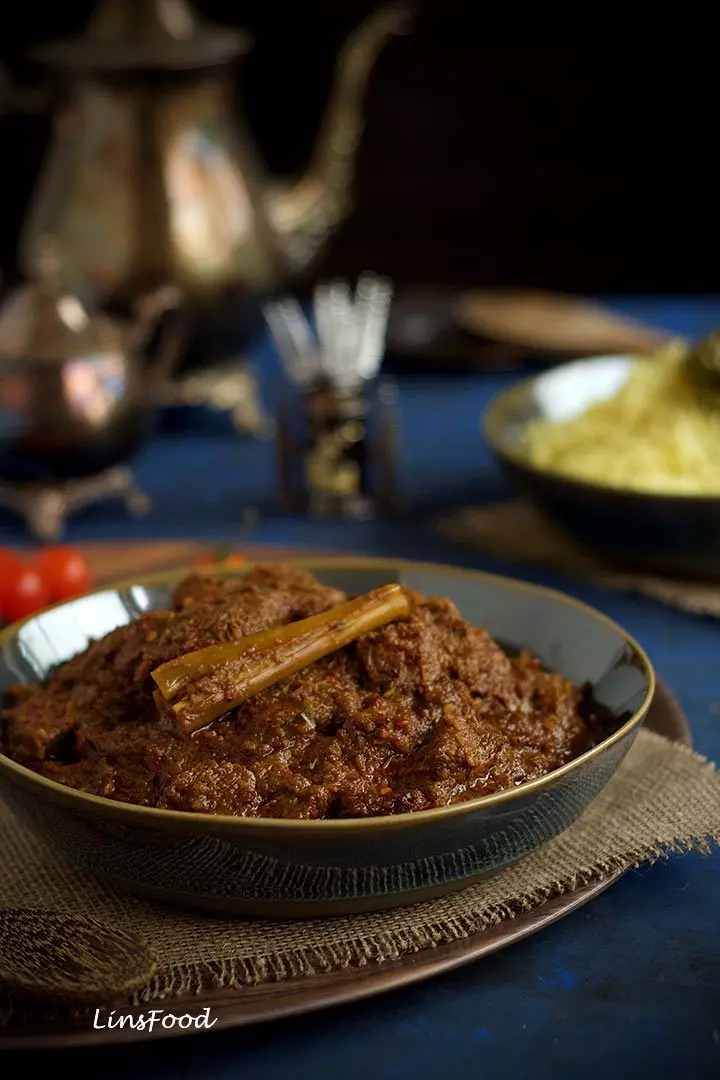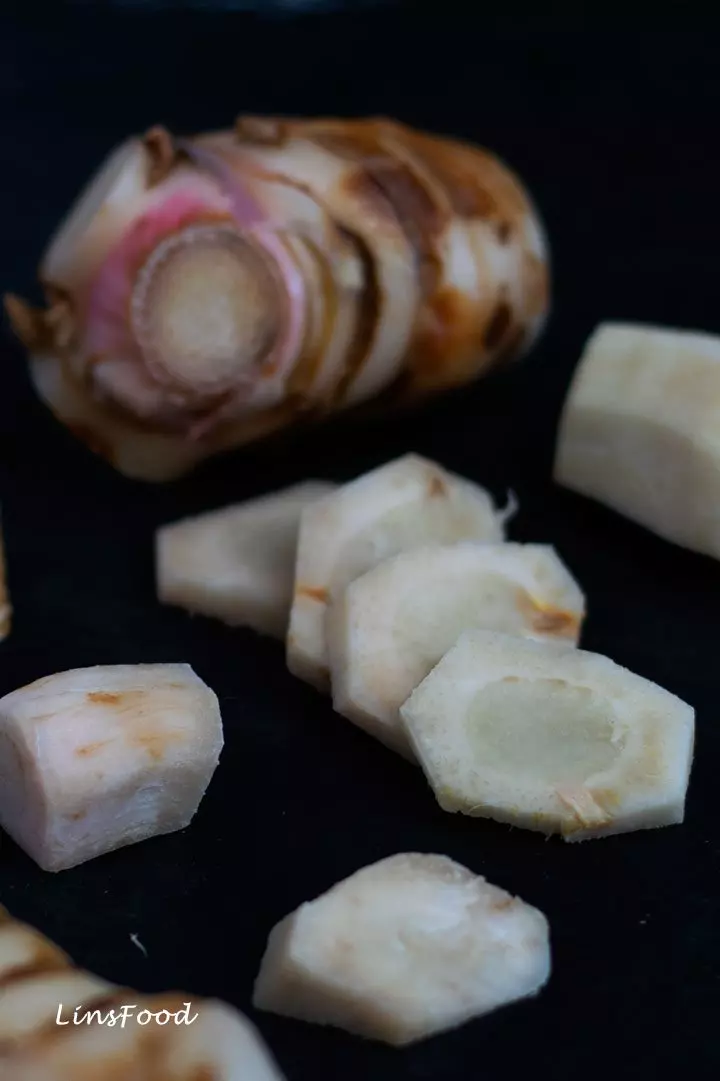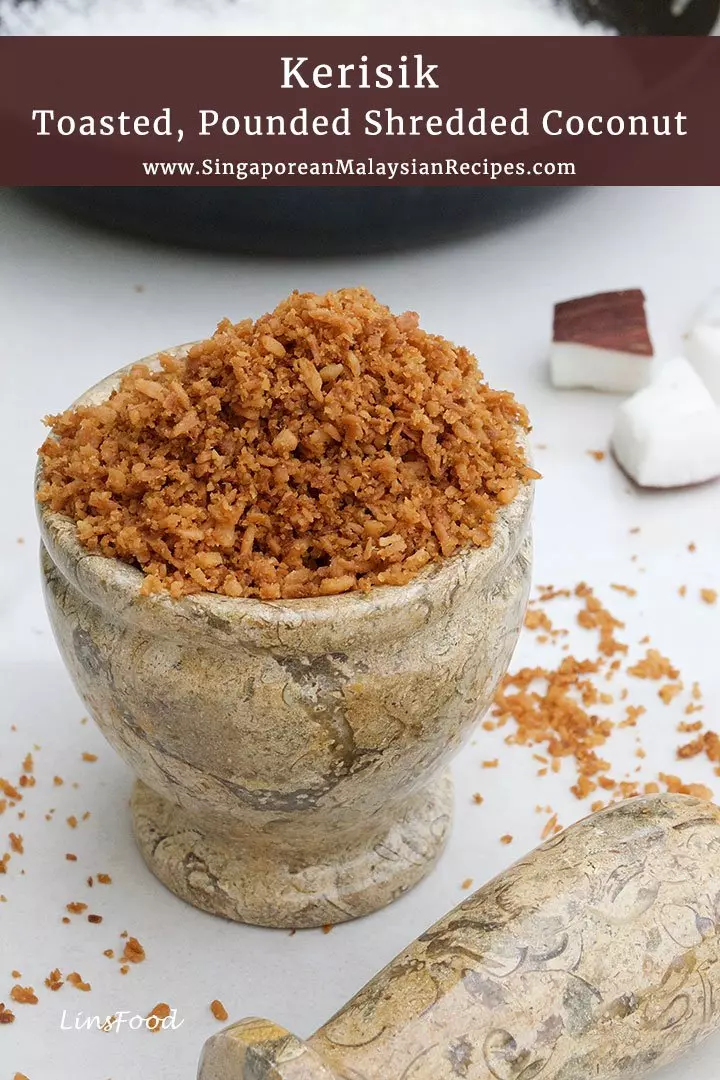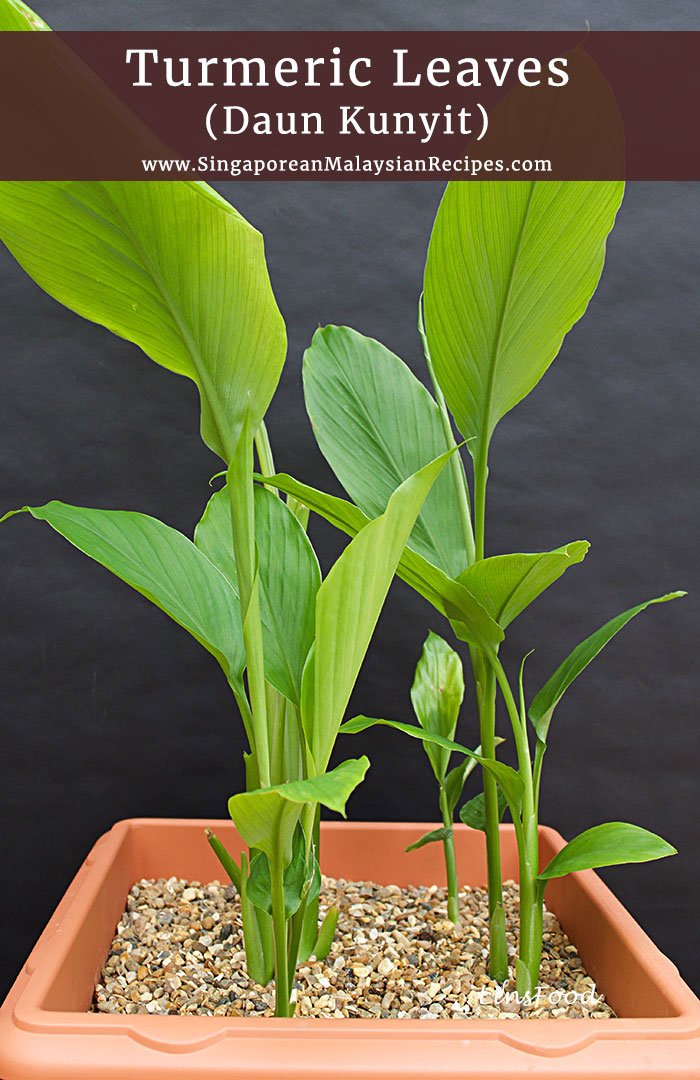Beef Rendang or rendang daging, in Malay/Indonesian, is a curry fit for a King. It’s a curry with meltingly tender beef that’s been slow cooked in a rich, aromatic and highly spiced coconut gravy that will keep you coming back for more. And more!
Estimated reading time: 8 minutes

Where does Beef Rendang come From?
Originally from Indonesia, going as far back as the 15th century, beef rendang started out life very humbly; it was a method to cook down and preserve tough buffalo meat, the privilege of the rich in the villages of West Sumatra, Indonesia, where it is said to have originated.
The buffalo meat rendang daging would be packed in banana leaves and taken on the frequent long, arduous journeys that many workers would embark on, in their quest for new jobs in nearby cities and villages. It would keep up to 4 weeks, apparently.
But beef rendang has long been adopted and considered a local dish by the Malays in Singapore and Malaysia.
Traditionally, no Malay wedding is complete without beef rendang, or rendang daging (daging = meat) as we would call it in Malay, just as no Hari Raya (Eid) table is quite right without this most regal of dishes. Mine certainly isn’t!
At Christmas, we can’t do without a homemade Christmas pudding, at Eid, we can’t do without beef rendang!
What Makes Beef Rendang so Special?
In my opinion, it’s the combination of spices and aromatics and the low and slow cooking. Galangal, ginger, lemongrass – these 3 aromatics alone are enough to spike any recipe. But add to that, we have coconut milk as well as the toasty and caramel-like kerisik (dry toasted coconut).
The result is a creamy, yet full-bodied, potent, and highly perfumed dish that will enslave you from your very first mouthful.
Nay, from your very first sniff!
Beef Rendang Recipe
So many of my childhood recipes had their beginnings in my granny’s kitchen. However, this beef rendang recipe (resepi rendang daging) belongs firmly with my mother. She was a nurse until she retired, and was also a well known recording artist in her late teens and 20s.
She and my late uncle were popular for the Malay songs they used to sing. Many of those songs were Malay renditions of popular Hindi songs with my uncle doing the translating.
Got a Malay background? Ask your older family members if they know the late Zainab Majid and her brother, the late Razak Majid. That’s mum and my uncle.
I have distinct memories of cooking this with her when it was just the two of us in our apartment (our family was always all over the place!).

The method of cooking this beef rendang is something she learnt from her aunt in Ipoh, Perak (Malaysia), where the popular royal Rendang Tok is said to have originated.
- Basically, in our recipe, there’s no initial sautéeing involved.
- We just place everything into a saucepan or a Dutch oven, and let it cook away on low heat for a good 2 1/2 to 3 hours.
- At 3 hours, you will have meat that’s practically falling apart, which is the hallmark of a good beef rendang.
- You can also stop cooking earlier, as long as the meat is cooked, for a wetter curry.
That is another thing about beef rendang – to each his own is carried to another level with this curry, while still respecting the boundaries.
Beef Rendang Ingredients
Some dishes just call for difficult to find ingredients that you cannot substitute for and hope to recreate the same dish. And this is one of them.
Some of the links below for the ingredients are still on LinsFood.com. It will take me the whole of 2021 to move everything over!
Galangal (lengkuas in Malay)
Click to read more on galangal. The curry won’t work as well without it, I’m afraid.
Galangal has a sharp, floral, sweet and almost piney aroma and flavour. It is a different ingredient altogether from ginger, in terms of uses. Ginger is citrusy and spicy. So these 2 are not interchangeable. No matter what you may read on other food sites.
The good news is, in the UK, galangal paste is easy to come by; it’s sold in larger supermarkets like Waitrose and Sainbury’s.
1 tsp paste = 1″/2.5cm fresh galangal.

Kerisik
Click here to read more on Kerisik, on LInsFood. As mentioned above, this is just diy dry roasted/toasted desiccated coconut. However, be sure to get desiccated coconut without any sugar added, and ideally, no preservatives.
I will show you how to do this in the video below. All you need is 4 Tbsp of fresh grated coconut or desiccated coconut, and follow the video.

Turmeric Leaves (daun kunyit in Malay)
Click here to read more about turmeric leaves and how to grow them. Turmeric leaves have a grassy and citrusy constitution that is the defining aroma of an authentic Singaporean and Malaysian beef rendang.
Outside of Asia, they are probably not easy to come by but the good news is, if you have access to fresh turmeric, then you can grow them yourself! As long as the weather is warm.
Just pot up a fresh tuber in compost and keep somewhere bright and mild, like a windowsill. In fact, even in the cold of winter, if you leave turmeric tubers long enough in the kitchen, they will produce shoots.
Kaffir lime leaves are not a substitute for turmeric leaves but they are an acceptable alternative, if you cannot get hold of turmeric leaves.

Chillies (chili peppers)
This is traditionally a spicy curry. But you can cut those dried red chillies right down for a milder version. I always make 2 separate lots, one a fairly spicy version, the other, a very mild one, for the younger kids.
Speaking of ingredients, beef rendang offers some latitude in the spices that you can use to cook it.
Some cooks will make it more curry-ish, adding cumin and cinnamon to the mix. Others leave all these spices out, no coriander and turmeric either, as in my recipe here.
And there are plenty of folks who add tamarind (asam) to their beef rendang for just that bit of sour and some will add gula melaka, or palm sugar for an extra hint of caramel, along with the kerisik. I must confess, that I chop and change sometimes too!
Ground Ingredients in Beef Rendang
You do need a chopper or blender for this to work best. Add the ingredients in the order that they’ve been listed, giving the earlier ingredients (the more fibrous ones) a better opportunity to be ground to a finer stage.
Coconut Milk – always cook on a low heat when cooking with coconut milk. Otherwise, your milk will split, even the canned variety with stabilisers can be temperamental sometimes.
Can you use other meat to make Rendang?
Absolutely, just substitute it, pound for pound. In fact, chicken rendang, or rendang ayam is also a very traditional dish in these countries.
When cooking chicken rendang (click for recipe), you want to use meat on the bone for a tastier curry.
And, if you know someone who’s vegetarian, I have a Vegan Rendang recipe for them too. Just click here to get the recipe.
Edit 2024: This article was first published on LinsFood years ago. Since then, my kids have all gone vegetarian (1 pescatarian). So I make them rendang with vegan protein pieces, using this exact recipe.


How to Serve Beef Rendang
Given that it is a very rich curry, whatever accompaniments you have will lean towards, erm, lean.
- Nasi minyak, which is the Malay equivalent of pilau rice, is a very traditional accompaniment to beef rendang.
- Plain steamed rice or flatbreads, are also another great way to serve this beef rendang.
- Another starch that is popular with rendang daging is Roti Jala, a lacy pancake that is simplicity itself and that I’ve been meaning to blog for a long, long time. My sister in law even got me the contraption to make it the last time they visited from Singapore, about 3 years ago! So, again, watch this space.
- Lemang is the perfect recipe for to go with our Beef Rendang! Lemang is glutinous rice that’s traditionally cooked in banana leaf lined bamboo poles. While in Malaysian and Indonesian villages, families may cook it themselves, it has long been something most folks buy at food stalls, and especially night markets.
The recipe here is my version of it, without using the impossible-to-get bamboo poles for cooking! For all of us who no longer live in the countries we were born in. - And remember the pachri nenas from a few weeks back? The pineapple salsa? That will go so well with beef rendang, as an accompaniment.


And on that note, shall we get our aprons on?
♥ If you like the recipe and article, don’t forget to leave me a comment and that all important, 5-star rating! Terima kasih! ♥
And if you make the recipe, share it on any platform and tag me @azlinbloor, and hashtag it #linsfood
Lin xx
